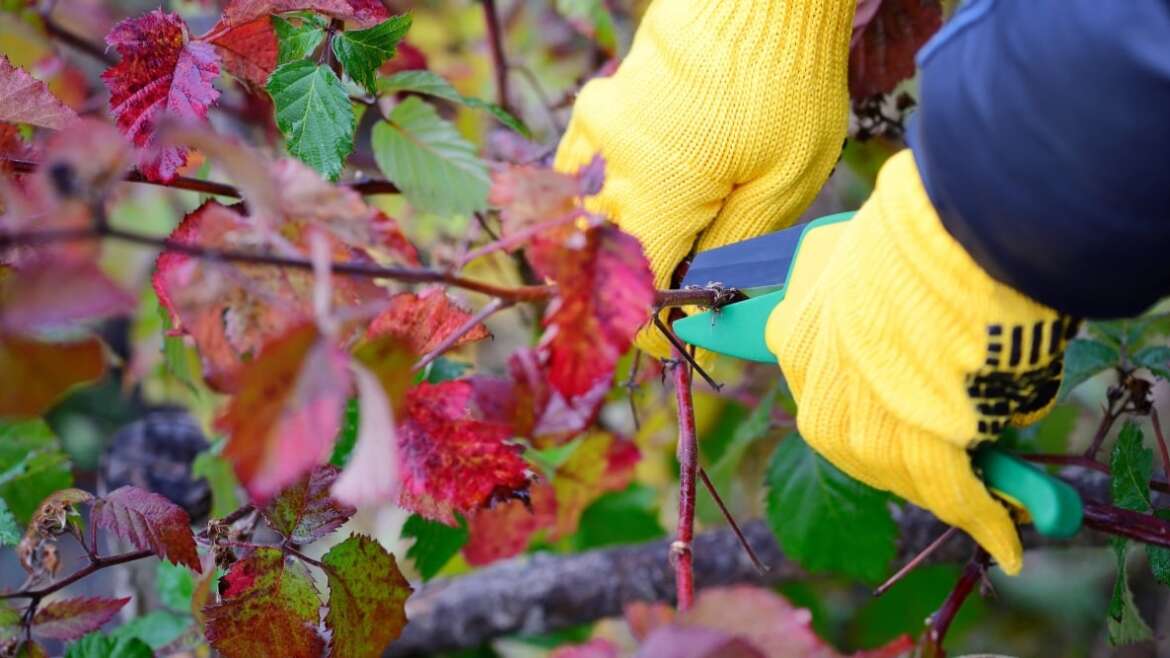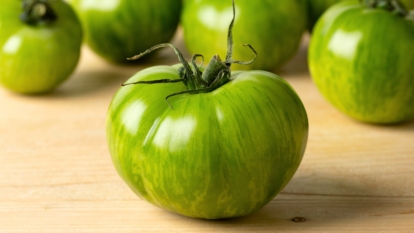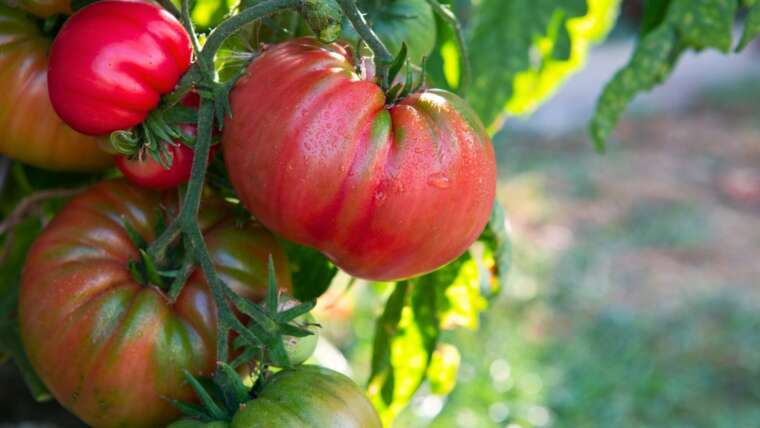Growing blackberries is incredibly rewarding and economical. Fresh fruit can be expensive, and store-bought berries often lack flavor. But if you dream of plucking tasty ripe blackberries from backyard vines all summer long, pruning is an essential skill. While blackberry pruning can be intimidating at first, a few quick tips can make these twice-annual haircut sessions super easy.
Unpruned blackberry vines grow wild and unruly, often becoming diseased and difficult to control. Proper pruning ensures more abundant yields, healthier vines, and tidy trellises for aesthetically pleasing landscapes.
Let’s dig into 10 quick tips that will help you prune like a pro every season!
How Do I Prune Blackberries?
The goal is to leave about four to six canes per plant to encourage healthy new growth.
When plants are dormant in late winter or early spring, use sharp, sanitized pruners to cut out overcrowded, diseased, or damaged blackberry canes. The goal is to leave about four to six canes per plant to encourage healthy new growth and abundant fruiting.
Lateral side shoots can be pruned to 12-15 inches to promote larger berries, and trailing varieties should be trained to keep them on their trellises. For everbearing types, you can also cut all canes back to ground-level to promote regrowth in the spring.

It’s best to prune the plants again in late summer after they finish fruiting. You can remove the tips of new canes once they are 30-36 inches tall. This is called “pinching,” and it promotes higher yields by encouraging side branching. Older canes can be cut back to the ground after the last harvest because they won’t produce fruit in the following season. It’s important to remove clippings from the garden to prevent disease.
Benefits of Pruning
 Learning this skill can dramatically improve your berry plants’ performance.
Learning this skill can dramatically improve your berry plants’ performance.
Many gardeners avoid pruning, but learning this skill can dramatically improve your berry plants’ performance.
Proper shearing ensures:
- Higher berry yields
- Less risk of disease
- Better airflow
- Fewer pests
- Tidy, attractive plants
- Easier trellising
10 Pro Tips for Pruning Blackberries
 These plants are very forgiving and usually grow back after any mistakes.
These plants are very forgiving and usually grow back after any mistakes.
Pruning is overwhelming for most gardeners. But just like hair stylists learn to trim dead ends, we can all learn to better cut back our blackberries. These plants are very forgiving and usually grow back after any mistakes.
Know Your Blackberry Type
 Once the plant matures, you can also leave second-year wood to produce a second crop of fruit.
Once the plant matures, you can also leave second-year wood to produce a second crop of fruit.
The most beginner-friendly type of blackberry is called an everbearing or primocane-bearing variety. Ideally, you can also find a thornless type. Why whack through poking thorns if you don’t have to?
If you want to take the complications out of pruning, we highly recommend choosing a primocane-bearing variety!
‘Prime-Ark Thornless’ is our top pick because it is everbearing, thornless, and self-fertile. The tall single shrubs can pollinate themselves, but growing multiple plants can improve overall yields. This variety is hardy in USDA zones 4 through 9.
Better yet, it can simply be mowed down after the fall harvest so it can overwinter underground and generate new growth and fruit the following summer. Once the plant matures, you can also leave second-year wood to produce a second crop of fruit.
Everbearing plants produce fruit in the first year from new shoots called primocanes. They are significantly easier to prune because you don’t have to worry about sorting through primocanes versus floricanes. Still, it’s helpful to understand the difference so you can grow an abundance of berries. Multiple varieties and proper pruning can ensure continuous berry harvests from spring through fall.
Primocanes vs. Floricanes
 Most blackberries are considered floricane-producing.
Most blackberries are considered floricane-producing.
The fancy names for the vines are the most confusing part about blackberries. What are canes, primocanes, and floricanes?
Here is a super simple explanation of the different types of canes:
- Canes: Also known as shoots, these are the long woody stems that grow from the crown of the blackberry plant. Cane is another word for a blackberry or raspberry branch. Thornless canes are ideal if you don’t want to get poked.
- Primocanes: This year’s new green growth; think “primo” as in first. Primocanes are pliable
- Floricanes: Second-year shoots are dark red or brown. Most varieties produce flowers and fruit on the older second-year floricanes.
Most blackberries are considered floricane-producing. This means they grow their delicious berries on second-year canes. In other words, the canes won’t produce until they are a year old. You must keep this in mind when pruning! If you have an everbearing type (more rare), be sure to check out the caveat below.
Every cane on your blackberry plant goes through the same cycle of growth. They emerge in the spring as a primocane and age to a floricane the following year. It’s easy to confuse these two terms, but all you need to remember is that primocane describes a new shoot, and floricane describes an older shoot. Most plants have both at the same time.
Here is a chart to further delineate between primocanes and floricanes:
| Primocanes | Floricanes |
| First-season shoots (this year’s growth) | Second-season shoots (last year’s growth) |
| Primo = first | Floro = flower |
| Fresh green growth | Older woody growth |
| Doesn’t usually produce fruit (unless you have a primocane-bearing variety) | Produces flowers and fruit |
| Bright green, pliable, soft stems | Brown or red, woody stems |
Key Caveat for Primocane Everbearing Types
 These types can be cut down to ground-level in late winter or early spring.
These types can be cut down to ground-level in late winter or early spring.
Primocane-fruiting blackberry varieties like ‘Prime-Ark Freedom,’ ‘Prime-Ark Horizon,’ and ‘Stark Black Jim’ produce high yields of fruit on everbearing plants.
These types can be cut down to ground-level in late winter or early spring. This is because the plants produce fruit on the same year’s canes. Cutting or mowing the whole plant back encourages new shoots for a bountiful harvest the following summer.
Once the plants mature, you can allow second-year floricanes to persist, which will help the plant provide two big harvests of berries per season: one harvest on the primocanes, and a second harvest on the floricanes.
Timing Matters
 Spring pruning focuses on overall structure, disease-prevention, and preparing the plants for fruiting.
Spring pruning focuses on overall structure, disease-prevention, and preparing the plants for fruiting.
The best time to prune blackberries is in late winter or early spring. For most temperate climates, the ideal window is between December and February. The plants are dormant (without leaves), which makes it easier to sort through the canes.
Many gardeners do another light pruning in late summer after the plants are done fruiting. Spring pruning focuses on overall structure, disease prevention, and preparing the plants for fruiting. In contrast, late summer fruiting is less intense. You won’t remove as much plant matter. Instead, the late summer pruning focuses on pinching off the cane tips to promote more bushing and flowering next year.
Sharpen and Sanitize Your Tools
 Sanitization is crucial for any pruning activity.
Sanitization is crucial for any pruning activity.
You will need hand held pruners for smaller canes and large garden loppers for thicker canes. Sanitization is crucial for any pruning activity, especially in humid regions with a high risk for plant disease.
Always start your pruning tasks by sharpening and sanitizing your tools. I love Felco pruners because they stay sharp for so long, thanks to a specialty heat-treating and hardening process. Replacing the blade is also safe and easy.
To clean your tools, wipe with a soapy sponge and dry them on a towel. When pruning, keep a small spray bottle of diluted bleach solution handy. You can spray the blades in between plants to prevent transferring spores or pathogens between vines.
Remove Dead Canes
 Get down to the base of the dormant plant and start looking for dead canes.
Get down to the base of the dormant plant and start looking for dead canes.
Once you’ve covered all the preparation and planning, pruning is actually the easy part. Get down to the base of the dormant plant and start looking for dead canes. These are the first cuttings to remove because they clear out space to make pruning easier. More importantly, they ensure proper airflow near the crown so you don’t have to worry about crown rot.
However, you may feel nervous about spotting dead canes. After all, the plant doesn’t have any leaves, so everything looks kind of dead. Don’t worry, there are some simple ways to decipher between dormant canes and dead ones.
Visual cues for dead or diseased blackberry canes include:
- Hollow feeling (living canes feel sturdy and solid)
- Weak or floppy
- Very dry and brown, silvery, or gray
- No buds (living canes may have emerging green buds or small leaves)
- Tan interior (living canes will have bright green inside)
- Small black specks of dead, black fungi (key signs of cane blight disease)
- Visible damage from insects, mowing, or frost injury
- Split bark that is very brittle
Remove any plant parts with these cues! Use your pruners to cut these canes as close to the base of the plant as possible. Remove all clippings from the garden. You can compost them as “brown” material or add them to your yard waste bin.
If the prunings appear diseased, it’s best to burn them or throw them in the trash. Be sure to spray your pruners with sanitizer before continuing!
Thin Out Overcrowded Canes
 Overcrowding is one of the most common reasons for plant disease.
Overcrowding is one of the most common reasons for plant disease.
Once you’ve removed the dead and diseased shoots, it’s time to focus on airflow. Overcrowded blackberry canes give these plants their nickname, “brambles.” But most of us don’t want brambles in our garden—we want tidy, happy, healthy berry plants that are easy to harvest and pretty to look at.
Overcrowding is one of the most common reasons for plant disease. When too many vines and leaves get clustered together, it creates stagnant air where humidity and fungi thrive. Moreover, thinning the canes signals to the plant to focus its energy on berry production. If you’ve ever pruned tomatoes or cucumbers, this method will sound familiar.
To thin overcrowded canes:
- Start by removing any lateral branches less than 18” off the ground.
- Make all cuts as clean and straight as possible. Avoid shredding or ripping the plant.
- Choose 4-6 of the strongest primocanes to keep. In a row, this may be about 3-4 canes per foot.
- Remove any weaker canes between the selected primocanes.
- Cut back any cris-crossing vines.
Trim Lateral Branches to 5-6 Buds
 You may notice horizontal branches growing off of the main canes.
You may notice horizontal branches growing off of the main canes.
You may notice horizontal branches growing off of the main canes. These side shoots can produce abundant fruit, but you don’t want them to grow unruly. If they are crossing over their neighbors or entangling with other canes, the tips need to be tamed.
Cut the lateral branches to about 12-18” long. Ensure that each branch has at least 5-6 buds (small nubs along the stems) leftover.
Train Canes Along a Trellis
 Regularly tie new canes to the trellis to keep them upright.
Regularly tie new canes to the trellis to keep them upright.
As spring triggers bud break and new growth, it’s important to keep your blackberries growing in the right direction.
If you have a compact or bush variety, you may not need to use a trellis. These types have self-supporting canes that can stand upright on their own. They may appreciate a stake or support in areas with high winds, but they tend to grow like shrubs.
However, if you have a semi-erect or trailing blackberry cultivar, a strong trellis is crucial for long-lasting growth and support. A raspberry trellis system works equally well for blackberries. All you need are wooden posts, crossbeams, and wires. This video explains the details:

Regularly tie new canes to the trellis to keep them upright. New canes often try to trail along the ground. If canes fall, it may be difficult to lift them back up once they get woody. Earlier trellising is always easier. You can angle the growth tip toward the desired direction.
Summer Pruning After Fruit Harvest

Most blackberries benefit from top pruning in the summer. Erect varieties should be pruned to 12-18 inches tall, so they remain manageable and accessible during harvest. Semi-erect and trailing varieties are best kept at three to five feet to ensure you can still access the top growth.
After your canes are done fruiting, you can do these late summer pruning tasks:
- “Head” or “top” the main canes to 3-5 feet.
- Thin out spent floricanes. After a cane bears fruit, it dies, so there is no need to keep it on the plant. Removing these canes earlier will clear the way for more new growth.
- “Tip” or “pinch” the spent ends of primocanes. Everbearing varieties will often have green, growing primocanes with withered brown ends. Don’t cut back the whole cane! Instead, just remove the berry debris and dead tips.
Remember, if you’re growing primocane-fruiting blackberries, you can selectively remove dying floricanes as soon as they stop fruiting. You don’t have to do all the pruning at once. Instead, pay attention to withering canes as you pick berries throughout summer. Earlier removal will make it easier to prune in the winter season.
Don’t Stress It

If you accidentally mix up your canes or forget to prune your blackberries, don’t worry! Your plants will likely be fine. However, an overgrowth of old canes and dead leaves will eventually lead to less fruit and more disease susceptibility. Maintenance is key, but sometimes life happens. These brambling berries are very forgiving, even in the worst of care. That’s why you often see wild blackberries doing just fine without human intervention!
If you need to reclaim an overgrown blackberry bush or patch, here’s how to renovate your plants:
- First, prune out the worst canes. Remove anything dead, damaged, or diseased.
- It’s OK to be more ruthless with your cuts when renovating a patch. The goal is to reclaim the blackberry brambles. You can worry about fruiting later.
- Cut main canes back to 6-12” long so you can easily access the patch.
- Remove all weeds and try to avoid uprooting crowns. If you do, you can replant the crown in another part of the bed.
- Thin to 3-4 canes every foot.
- Add a generous layer of leaf mulch or straw.
- Don’t expect a huge fruit set in the year after renovation. Return to regular pruning the following season.
FAQS
Late winter and early spring (December through February) are the best times to prune blackberries because the canes are leafless and dormant, making it easy to locate where to cut. Select 4-6 strong canes and remove any overcrowded shoots. Cut back side-branches to 12-15”. Erect and semi-erect berry varieties can be pruned again (“tipping”) in late summer by cutting canes back to 3-4 feet tall.
Thornless blackberries still need to be pruned, but the task is much easier and softer on the hands. Pruning is crucial for maintaining healthy, vigorous, disease-free growth. Focus on removing spent fruiting canes, cutting back damaged or old branches, and increasing airflow between plants.
Most blackberries produce on second-year wood called floricanes. However, some hybridized types (sold as “everbearing” or primocane-bearing blackberries) produce fruit on first-year primocanes. After a cane produces fruit, it dies. Pruning away spent floricanes makes way for new growth, but avoid pruning primocanes because they will produce berries the following year.




